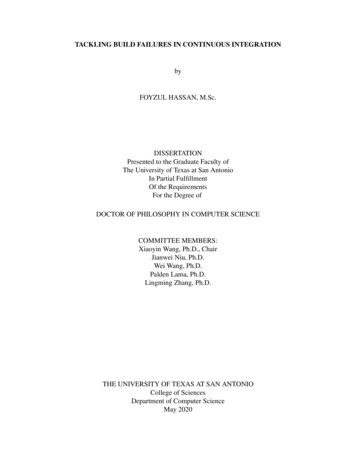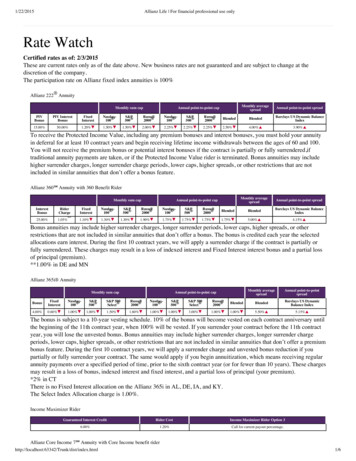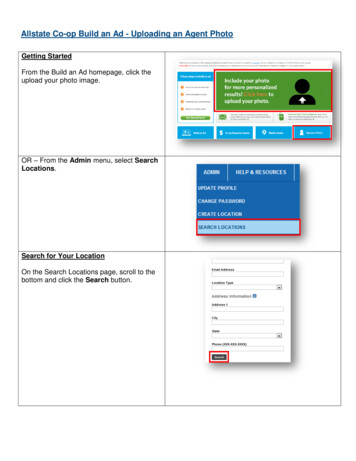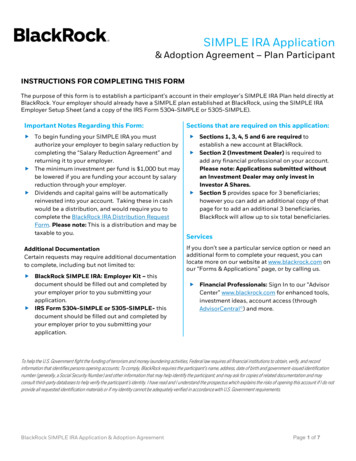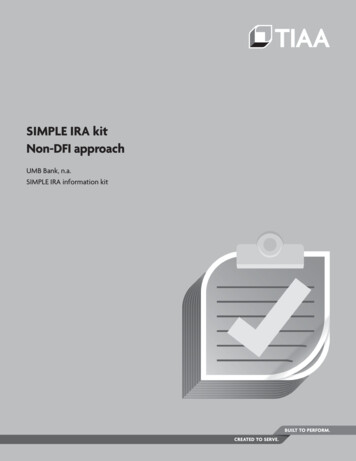
Transcription
AN5418Application noteHow to build a simple USB-PD sink application with STM32CubeMXIntroductionThis application note is a guideline to build a very simple USB power delivery sink example, starting from STM32CubeMX. Thisdocument applies to STM32 MCUs embedding the UCPD peripheral.The principal hardware used in the different screenshots is based on the STM32G0 Series microcontroller with its associatedfirmware included in the STM32CubeG0 MCU Package, but some notes are added to this document so that the STM32G4Series microcontroller with its associated firmware in STM32CubeG4 can also be used. The associated firmware of theSTM32L5 Series microcontroller is in STM32CubeL5.To ease connections with USB Type-C signals, the STM32G0 and STM32G4 Nucleo-64 boards are equipped with the XNUCLEO-USBPDM1 shield. The STM32L5 Nucleo-144, Discovery, and Evaluation boards are USB-PD ready as they embedthe TCPP01-M12 chip.Figure 1. STM32G0 Nucleo-64 board equipped with X-NUCLEO-USBPDM1 shieldAN5418 - Rev 1 - January 2020For further information contact your local STMicroelectronics sales office.www.st.com
AN5418General information1General informationThe simple USB-PD sink application runs on STM32G0 Series, STM32G4 Series, and STM32L5 Series 32-bitmicrocontrollers based on the Arm Cortex -M processor.Note:AN5418 - Rev 1Arm is a registered trademark of Arm Limited (or its subsidiaries) in the US and/or elsewhere.page 2/39
AN5418Acronyms2AcronymsTable 1. Acronym definitionsAcronymAN5418 - Rev 1DefinitionAMSAtomic message sequenceAPDOAugmented power delivery objectBSPBoard support packageCADCable detection moduleCCCommunication channel (As in CC lines)DPMDevice policy managerDRPDual role power (The ability for a product to either source or sink power)DRSData role swapGUIGraphical user interfaceHALHardware abstraction layerHWHardwareLLLow layerOVPOver-voltage protectionPDOPower delivery objectPEPolicy engineSNKPower sink capabilityUCPDUSB type C power deliverypage 3/39
AN5418Reference documents3Reference documentsSTMicroelectronics ecosystem material: STM32CubeMX: STM32Cube initialization code generator User manual Managing USB power delivery systems with STM32 microcontrollers (UM2552) User manual STM32CubeMonitor-UCPD software tool for USB Type-C Power Delivery port management(UM2468) Datasheet TCPP01-M12 USB type-C port protection (DS12900) Application note USB Type-C protection and filtering (AN4871) Databrief STM32CubeMonitor-UCPD software tool for USB Type-C Power Delivery port management(DB3747) Technical article Overview of USB Type-C and Power Delivery technologies (TA0357) Application note USB Type-C Power Delivery using STM32xx Series MCUs and STM32xxx Series MPUs(AN5225) Youtube video STM32G0: Create a USB Power delivery sink application in less than 10 minutes X-NUCLEO-USBPDM1 user manual (UM2668)USB specification documents: USB2.0 Universal Serial Bus Revision 2.0 Specification USB3.1 Universal Serial Bus Revision 3.2 Specification USB BC Battery Charging Specification Revision 1.2 Universal Serial Bus Type-C Cable and Connector Specification 2.0, August 2019. Universal Serial Bus Power Delivery Specification, Revision 3.0, Version 2.0, August 28, 2019AN5418 - Rev 1page 4/39
AN5418Getting started4Getting startedThe very first goal is to configure the UCPD peripheral with USB-PD stack, and check that a first contract isreached. So any wall charger or any power delivery certified source is also needed.To reach this goal, the following steps are necessary:1.Set up the UCPD peripheral to expose Rd resistors on the CC lines and detect the Rp from the source,using STM32CubeMX.2.Read the VBUS from the attached source. The initialization part is done by STM32CubeMX, but themeasurement start must be added manually in the application.3.Finally, send a power delivery request message to the source and reach an explicit contract. This can onlybe done manually, by editing the application files, after they are generated by STM32CubeMX.Optional steps are described in this document, to help the user to debug:4.Addition of a trace utility that uses the ST-LINK Virtual COM port to get some debug information from theboard5.Addition of an embedded tool to communicate with a Java application (GUI) to help to build the applicationAN5418 - Rev 1page 5/39
AN5418STM32CubeMX step-by-step sequence5STM32CubeMX step-by-step sequence5.1Mandatory partsThe below steps can be done because of the presence of the UCPD peripheral in some STM32 devices, such asSTM32G071xx and STM32G431xx. This peripheral manages power delivery communication over the CC lines.The X-NUCLEO-USBPDM1 shield, embedding the TCPP01-M12 single-chip solution, adds the microcontrollerprotection on the CC lines, such as over-voltage and over-temperature, and it also gives access to a USB TypeC receptacle.Note that TCPP01-M12 is already embedded in the STM32L5 Nucleo-144, Discovery, and Evaluation boards.5.1.1Start STM32CubeMX and select the MCUFigure 2. Start STM32CubeMXCreate a new project File/New Project or click on ACCESS TO MCU SELECTOR, and check STM32G0 andLQFP64 package, to filter available MCUs, double click on STM32G071RB.AN5418 - Rev 1page 6/39
AN5418Mandatory partsFigure 3. Select the STM32G0 MCU5.1.2UCPD peripheral configurationNow it is possible to activate the UCPD peripheral inside the microcontroller.This peripheral manages the power delivery detection and its communication over the CC lines. For more details,refer to section 35 USB Type-C / USB Power Delivery interface (UCPD) of STM32G071 reference manual(RM0444).Click on Connectivity, and select UCPD1. STM32G0 has two instances of the UCPD block. On the TCPP01shield, UCPD instance number 1 is used.This demonstration runs a sink application. So for UCPD mode, the user selects Sink. Untick the Dead BatterySignals to avoid using the internal dead-battery management of the UCPD peripheral, because, in thedemonstration, the ST-LINK is powering the kit (Nucleo and shield) and the dead-battery management of theTCPP01 is bypassed, as DB-3.3V jumper is ON, to start with an easy application.AN5418 - Rev 1page 7/39
AN5418Mandatory partsFigure 4. UCPD peripheral basic configurationNow the DMA for TX and RX paths must be added, and the interrupts enabled.Figure 5. UCPD peripheral DMA configurationAN5418 - Rev 1page 8/39
AN5418Mandatory partsOur device requires DMA initialization for the PD communication through the UCPD peripheral, so the user mustconfigure a DMA channel for TX and RX. For example, set RX on DMA1 Channel 1, and TX on DMA1 Channel 2.Figure 6. UCPD peripheral IT activationTwo DMA handlers are enabled but they are not directly used by the firmware. All the UCPD treatments are donethrough UCPD handlers.5.1.3FreeRTOS configurationIn the middleware category, enable FreeRTOS .Select CMSIS V1 and set TOTAL HEAP SIZE to 5000. From STM32L5 and further firmware package deliveries,CMSIS V2 must be selected instead of CMSIS V1.Heap size here is for a start. It must be tuned later when optimizing the final application.Figure 7. FreeRTOS configuration5.1.4USB-PD middleware configurationIn the middleware category, select USB-PD, then UCPD1 in stack configuration mode. For more details on USBPD stack role in the overall firmware, refer to the user manual Managing USB power delivery systems withSTM32 microcontrollers (UM2552).AN5418 - Rev 1page 9/39
AN5418Mandatory partsFigure 8. USB-PD middleware configurationCheck that port 0 Sink PDO1 is set to 0x02019096, even if it is not important, because it is unused in the currentsimple example. 0x02019096 means 5000 mV, 1500 mA, dual-role data, without Fast Role Swap. For furtherinformation, see table 6-14 in document Universal Serial Bus Power Delivery Specification, Revision 3.0, Version2.0, August 28, 2019, replicated below.Figure 9. Specification detail (table 6-14 in Universal Serial Bus Power Delivery Specification)AN5418 - Rev 1page 10/39
AN5418Mandatory partsFigure 10 gives an explanation of the applied value 0x02019096.Figure 10. Detailed PDO decodingFigure 11. Detailed stack configurationIn the Stack Port0 Parameters tab, the user selects what he wants to support, such as the PD3.0 specificationrevision, among other parameters.AN5418 - Rev 1page 11/39
AN5418Mandatory parts5.1.5ADC configuration for VBUS readingVBUS detection is mandatory to respect the Type-C state machines. For this, we use an ADC connected to avoltage divider bridge, to remain in the GPIO STM32 voltage range.Figure 12. TCPP01 shield voltage dividerLooking at the X-NUCLEO-USBPDM1 shield schematics, VBUS is on the ST morpho connector pin 34,corresponding to PB1Figure 13. STM32G0 Nucleo-64 board (left) and TCPP01 shield (right) schematicsIn the analog category, select ADC1.Clicking on the right side in STM32CubeMX, PB1 is connected to the ADC1 IN9 alternate function input. Soselect it in the mode part of the STM32CubeMX window, or select the ADC1 IN9 in the pinout view.AN5418 - Rev 1page 12/39
AN5418Mandatory partsFigure 14. ADC configurationThen in the GPIO settings tab, add the User Label VSENSE for this signal:Figure 15. ADC GPIO settingsAN5418 - Rev 1page 13/39
AN5418Mandatory partsSelect simple and basic settings for the ADC1: Clock Prescaler: Synchronous mode divided by 4 Continuous conversion mode: Enabled Overrun behavior: Overrun data overwritten Sampling time: 160.5 CyclesThe sampling time must be adjusted with the impedance linked to the measure. In the case of the X-NUCLEOUSBPDM1 TCPP01 shield, there are higher than 10 KΩ resistors, therefore a high number of cycles is preferred.Figure 16. ADC parameters settingsLast edition for ADC: A user constant VDDA APPLI with 3300 value is created, representing the ADC voltagereference of 3.3 V. This variable is called by the generated code.Figure 17. ADC user constantNote:AN5418 - Rev 1For STM32G4 Nucleo64, the ADC IN15 signal must be used, and the Rank sampling time can be set to 247.5Cycles.page 14/39
AN5418Additional recommended optional debugging5.1.6Clock checkHSI must be used because it is the UCPD clock. PLLCLK is selected as an input clock of the system clockmultiplexor, to produce SYSCLK and HCLK set to 16 MHz minimum. There is no limit for maximum. It can be170 MHz for STM32G4. HCLK is used to clock the UCPD peripheral, so it must be activated.Figure 18. Clock configurationThe mandatory settings for the simple USB-PD sink application are finished. The following part is highlyrecommended for debugging.5.2Additional recommended optional debugging5.2.1UART configuration for debugOn the STM32G0 Nucleo64, the Virtual COM port connected to the ST-LINK is the LPUART1.AN5418 - Rev 1page 15/39
AN5418Additional recommended optional debuggingFigure 19. STM32G0 Nucleo-64 board STLK connectionThis interface is activated in STM32CubeMX, in asynchronous mode. The pins used by LPUART1 are alsochanged to match the hardware: PA2 and PA3.Figure 20. LPUART1 activation and configuration for debugThen the DMA requests are activated for the TX path only: DMA1 channel 3AN5418 - Rev 1page 16/39
AN5418Additional recommended optional debuggingFigure 21. DMA activation for LPUARTAnd the interrupt is activated:Figure 22. DMA activation for LPUART1Note:If the STM32G4 Nucleo-64 board is used, USART1 must be used.5.2.2Activation of embedded tracer for debugThis is done in the utility category: TRACER EMB is selected followed by the LPUART1 in the source mode.AN5418 - Rev 1page 17/39
AN5418Additional recommended optional debuggingFigure 23. Activation of TRACER EMBBack to the USB-PD middleware configuration, the trace evacuation is activated: check the tracer source forTRACER EMB.Figure 24. Selection of USB-PD middleware TRACER EMB sourceAN5418 - Rev 1page 18/39
AN5418Update and save project configurationThe firmware interactive stack responder can be activated if interaction with the USB-PD stack is needed, usingthe UCPD monitor tool STM32CubeMonitor-Power STM32CubeMonPwr.5.2.3Activation of UCPD monitor firmware responderThe monitor can simply be activated in the utility category: GUI INTERFACE. Then enter free text to describe theboard.Figure 25. Activation of GUI INTERFACE5.3Update and save project configurationOnce the configuration is finished, few parameters must be saved in the project manager tab before saving theproject.Under the project manager tab, select a name for the project.Configure the minimum heap and stack size to 0x400. This is the first version, which can be tuned later,depending on the application.AN5418 - Rev 1page 19/39
AN5418Update and save project configurationFigure 26. Project manager settingsIn the Code Generator tab, STMicroelectronics recommends checking the Add necessary library files asreference tabAN5418 - Rev 1page 20/39
AN5418Update and save project configurationFigure 27. Code generator settingsClick on Advanced SettingsLPUART is selected as LL.Figure 28. Project advanced settingWork must be saved: menu file / saveAN5418 - Rev 1page 21/39
AN5418Code generation5.4Code generationClick on generate code.A warning appears, informing that a proper HAL timebase is not defined.It is safer to use a dedicated timer as a HAL timebase source.Note:This becomes the recommended standard way of working in the forthcoming firmware package deliveries,especially when using CMSIS OS V2, which defines Systick as FreeRTOS timebase. For this demonstration,the below warning can be ignored by clicking Yes.Figure 29. Generation warningThen it is recommended to initialize git in the source code directory to track the coming changes.5.5Compilation of generated applicationCompilation may be performed without error or warning.AN5418 - Rev 1page 22/39
AN5418Complete USB-PD applicationFigure 30. First compilationIn this project, different folders can be found: The Application/User folder contains the source files that we need to edit to enrich the application.5.6 The Drivers folder contains the HAL drivers for the STM32. The Middleware folder contains the source files and the libraries for FreeRTOS and USB-PD. The Utilities folder contains the GUI (UCPD monitor) and tracer embedded source files part. The Output folder contains the compilation result files.Complete USB-PD applicationNow that the peripherals are initialized by STM32CubeMX, some minimum level of the application needs to beadded: ADC needs to be calibrated, and conversion needs to start. DPM timer must be enabled to run the USB-PD stack. Fill the handlers for the interrupts to wake up the UCPD peripheral. Fill BSP USBPD PWR VBUSGetVoltage function with the right coefficient depending on the VBUS dividerbridge. Complete USBPD DPM SNK EvaluateCapabilities to answer to one source capability message. TCPP01 dead battery pin needs to be disabled, GPIO driven HIGH, to see the source Rp, or the jumper hasto be set on the shield.5.6.1Modification in src/main.cIn this file, the ADC must start after its calibration, using HAL. The ADC is needed to read VBUS.Code to be added:AN5418 - Rev 1page 23/39
AN5418Complete USB-PD application /* USER CODE BEGIN ADC1 Init 2 */HAL ADCEx Calibration Start(&hadc1);HAL ADC Start(&hadc1);/* USER CODE END ADC1 Init 2 */ Note:For STM32G4, ADC calibration API is different, the calibration line must be replaced by:HAL ADCEx Calibration Start(&hadc1, sConfig.SingleDiff);Note:This simple example is not optimized from power point of view, as the ADC is always running.5.6.2Modification in src/stm32g0xx it.c The USBPD DPM TimerCounter function is used to manage the stack timers. It must be called in thefunction which is responsible of the HAL timebase management. (SysTick in this case, or the correspondingTimer function for example)TRACE module needs a DMA and an IRQ handler. So the corresponding code must be added in the rightchannel/ IRQ placeThe UCPD handler must be added to be able to react upon coming interrupts, like cable detection ormessage reception. /* USER CODE BEGIN SysTick IRQn 0 */USBPD DPM TimerCounter();#if defined( GUI INTERFACE)GUI TimerCounter();/* needed with GUI Interface */#endif/* USER CODE END SysTick IRQn 0 */ /* USER CODE BEGIN DMA1 Channel2 3 IRQn 0 */#if defined( TRACE)TRACER EMB IRQHandlerDMA();#endif/* USER CODE END DMA1 Channel2 3 IRQn 0 */ /* USER CODE BEGIN USART3 4 LPUART1 IRQn 0 */#if defined( TRACE)TRACER EMB IRQHandlerUSART();#endif/* USER CODE END USART3 4 LPUART1 IRQn 0 */ /* USER CODE BEGIN UCPD1 2 IRQn 0 */USBPD PORT0 IRQHandler();/* USER CODE END UCPD1 2 IRQn 0 */ 5.6.3Modification in src/usbpd dpm user.cThe USBPD DPM SNK EvaluateCapabilities function needs to be added to have first contract. It is a very basicexample that requests the first default 5V PDO. This must be modified to match with real SINK PDOs, which isnot yet managed by STM32CubeMX.The part GUI INTERFACE compilation switch is needed if the user wants to interact with the UCPD monitor.AN5418 - Rev 1page 24/39
AN5418Complete USB-PD application /* USER CODE BEGIN USBPD DPM SNK EvaluateCapabilities */USBPD SNKRDO TypeDef rdo;/* Initialize RDO */rdo.d32 0;/* Prepare the requested pdo */rdo.FixedVariableRDO.ObjectPosition 1;rdo.FixedVariableRDO.OperatingCurrentIn10mAunits ts 50;rdo.FixedVariableRDO.CapabilityMismatch 0;*PtrPowerObjectType USBPD CORE PDO TYPE FIXED;*PtrRequestData rdo.d32;/* USER CODE END USBPD DPM SNK EvaluateCapabilities */ /* USER CODE BEGIN USBPD DPM SetDataInfo *//* Forward info to GUI if enabled */#if defined( GUI INTERFACE)if (NULL ! DPM GUI SaveInfo){DPM GUI SaveInfo(PortNum, DataId, Ptr, Size);}#endif/* USER CODE END USBPD DPM SetDataInfo */ 5.6.4Modification in src/usbpd pwr user.cIt is important to add this part in order to correctly read VBUS provided by the ADC. The stack needs to know theVBUS level all along the cable presence to determine the action to take. In case of SINK, the detach is done whenVBUS is below vSafe0V. /* USER CODE BEGIN include */#include "main.h"/* USER CODE END include */ /* USER CODE BEGIN BSP PWR VBUSGetVoltage */uint32 t val;val LL ADC CALC DATA TO VOLTAGE(VDDA APPLI, LL ADC REG ReadConversionData12(ADC1), LLADC RESOLUTION 12B); /* mV *//* X-NUCLEO-USBPDM board is used *//* Value is multiplied by 5.97 (Divider R6/R7 (40.2K/200K) for VSENSE) */val * 597;val / 100;return val;/* USER CODE END BSP PWR VBUSGetVoltage */ The calculation of val variable depends on the voltage divider shown in Figure 12. On the X-NUCLEOUSBPDM1 shield, Value is multiplied by 5.97 (Divider R6/R7 40.2 kΩ/200 kΩ) for VSENSE. For STM32G4,because of BSP v2.0, there is a slight change in this function interface. Instead of the line return val above,there must be:*pVoltage val;return BSP ERROR NONE;Note:AN5418 - Rev 1There is a known issue with STM32G4 in src/usbpd.c: GUI Init must be called after the USBPD DPM InitCore.This is fixed in the next STM32CubeMX version, STM32G4 FW 1.2.0 and further.page 25/39
AN5418Check jumpers5.7Check jumpersFigure 31. TCPP01 shield pictureVerify that the two jumpers to select the STM32G0 and STM32G4 configuration and located on the right areinserted. Then select the pins that are controlled by the MCU, using the left jumpers:Figure 32. TCPP01 jumper settingsAN5418 - Rev 1page 26/39
AN5418Check jumpers Fault detection and hard reset are not managed in this demonstration.The power consumption is also not optimized. This is the reason why the TCPP01 VCC is set to the fixed3.3 V, instead of taking an MCU GPIO, so the JP2 jumper VCC-3.3V [7-8] is ONIn the first step demonstration, the dead battery from the TCPP01 is not used, so the JP2 jumper DB-3.3V[11-12] is ON.And that ends the settings.Now it is time to check the first contract.AN5418 - Rev 1page 27/39
AN5418Establish the first explicit contract6Establish the first explicit contractCompile the application, flash the board, launch the UCPD monitor, and plug a power delivery source. The screenmust be:Figure 33. Explicit contract visible in UCPD monitorWe see the communication between the STM32G0 and the source code on the right panel. We can verify thecorrect sequence to reach an explicit contract:1.The capabilities are sent by the source (IN).2.The request is sent by the STM32G0 (OUT).3.The ACCEPT and the PS RDY are sent by the source (IN).For more details on how to use this tool, refer to UM2468.And for more details on the protocol, refer to UM2552.AN5418 - Rev 1page 28/39
AN5418How to debug a bit deeper6.1How to debug a bit deeper Add livewatch on CAD HW Handles. This variable can be used to check the Type-C attachment ordetachment.See usbpd cad hw if.c:#define USBPD CAD STATE RESET*/#define USBPD CAD STATE DETACHEDcted*/#define USBPD CAD STATE ATTACHED WAITdetected */#define USBPD CAD STATE ATTACHEDattached */0u/*! USBPD CAD State Reset1u/*! USBPD CAD State No cable dete2u/*! USBPD CAD State Port partner3u/*! USBPD CAD State Port partnerFigure 34. cstate 1: detachedFigure 35. cstate 3: attachedIf the CC lines are empty, check that the TCPP is passed through, which means that the active LOW DBpin is disabled at 3.3 V. This is due to the jumpers or some GPIO settings.Note:In the current STM32CubeMX for STM32G4, there is an issue with the default GPIO mode for CC2. Inusbpd cad hw if.c there must be:LL GPIO SetPinMode(GPIOB, LL GPIO PIN 4, LL GPIO MODE ANALOG);In STM32G4 versions before FW 1.2.0, the correct compilation switch is not set. An easy way to correct thisissue is to activate the compilation switch MB1367.AN5418 - Rev 1page 29/39
AN5418How to debug a bit deeper For further debug, the VBUS measured value can be printed in the trace, using the user button:Figure 36. User button on STM32G0 Nucleo-64 board schematicsAdd the button from STM32CubeMXFigure 37. Add the user button in STM32CubeMXAN5418 - Rev 1page 30/39
AN5418How to debug a bit deeperAdd in src/main.c:/*** @brief EXTI line detection callbacks* @param GPIO Pin Specifies the pins connected EXTI line* @retval None*/void HAL GPIO EXTI Falling Callback(uint16 t GPIO Pin){if (GPIO Pin USER BUTTON PIN) /* Will display in trace the VBUS value when user button is pressed */{char str[10];BSP PWR VBUSGetVoltage(0);sprintf( str,"VBUS:%d", BSP PWR VBUSGetVoltage(0));USBPD TRACE Add(USBPD TRACE DEBUG, 0, 0, (uint8 t*) str, strlen( str));}}And the corresponding interrupt in src/stm32g0xx it.c:/*** @brief This function handles external line 4 15 interrupt request.* @retval None*/void EXTI4 15 IRQHandler(void){HAL GPIO EXTI IRQHandler(USER BUTTON PIN);}AN5418 - Rev 1page 31/39
AN5418Next steps7Next stepsTCPP01 can be better controlled by driving its dead battery pin and its power.Figure 38. Modify TCPP01 controlsIf these pins need to be controlled by the application, the jumper positions must be adapted. The potential faultsmust also be read by setting the JP2 jumper in [5-6] position.Figure 39. TCPP01 shield jumpers position when application manages FLT, DB, and the TCPP01 VCCThe user application also needs to be done to react upon the TCPP01 fault detection (Over-temperature, overvoltage).AN5418 - Rev 1page 32/39
AN5418Conclusion8ConclusionThis demonstration is only the first step to a power delivery application.It is not optimized from the low power point of view.The USB PD application performed here is the minimum. No intelligence is added to select the power level bylooking at the proposal sent by the source. The mandatory hard reset management is also missing.To continue further, various demonstrations are available on STM32G0, STM32G4, and STM32L5. Check theProjects directory in the firmware package available in each serie, on the ST website. For instance, UCPDdemonstration on EVAL G0 is available under the folder .AN5418 - Rev 1page 33/39
AN5418Revision historyTable 2. Document revision historyAN5418 - Rev 1DateVersion9-Jan-20201ChangesInitial releasepage 34/39
AN5418ContentsContents1General information . . . . . . . . . . . . . . . . . . . . . . . . . . . . . . . . . . . . . . . . . . . . . . . . . . . . . . . . . . . . . . . 22Acronyms . . . . . . . . . . . . . . . . . . . . . . . . . . . . . . . . . . . . . . . . . . . . . . . . . . . . . . . . . . . . . . . . . . . . . . . . .33Reference documents . . . . . . . . . . . . . . . . . . . . . . . . . . . . . . . . . . . . . . . . . . . . . . . . . . . . . . . . . . . . . 44Getting started . . . . . . . . . . . . . . . . . . . . . . . . . . . . . . . . . . . . . . . . . . . . . . . . . . . . . . . . . . . . . . . . . . . .55STM32CubeMX step-by-step sequence. . . . . . . . . . . . . . . . . . . . . . . . . . . . . . . . . . . . . . . . . . . . . 65.15.25.1.1Start STM32CubeMX and select the MCU . . . . . . . . . . . . . . . . . . . . . . . . . . . . . . . . . . . . . 65.1.2UCPD peripheral configuration . . . . . . . . . . . . . . . . . . . . . . . . . . . . . . . . . . . . . . . . . . . . . . 75.1.3FreeRTOS configuration . . . . . . . . . . . . . . . . . . . . . . . . . . . . . . . . . . . . . . . . . . . . . . . . . 95.1.4USB-PD middleware configuration . . . . . . . . . . . . . . . . . . . . . . . . . . . . . . . . . . . . . . . . . . . 95.1.5ADC configuration for VBUS reading . . . . . . . . . . . . . . . . . . . . . . . . . . . . . . . . . . . . . . . . . 115.1.6Clock check . . . . . . . . . . . . . . . . . . . . . . . . . . . . . . . . . . . . . . . . . . . . . . . . . . . . . . . . . . . 14Additional recommended optional debugging . . . . . . . . . . . . . . . . . . . . . . . . . . . . . . . . . . . . . . 155.2.1UART configuration for debug . . . . . . . . . . . . . . . . . . . . . . . . . . . . . . . . . . . . . . . . . . . . . . 155.2.2Activation of embedded tracer for debug. . . . . . . . . . . . . . . . . . . . . . . . . . . . . . . . . . . . . . 175.2.3Activation of UCPD monitor firmware responder . . . . . . . . . . . . . . . . . . . . . . . . . . . . . . . . 195.3Update and save project configuration . . . . . . . . . . . . . . . . . . . . . . . . . . . . . . . . . . . . . . . . . . . . 195.4Code generation . . . . . . . . . . . . . . . . . . . . . . . . . . . . . . . . . . . . . . . . . . . . . . . . . . . . . . . . . . . . . . 225.5Compilation of generated application . . . . . . . . . . . . . . . . . . . . . . . . . . . . . . . . . . . . . . . . . . . . . 225.6Complete USB-PD application. . . . . . . . . . . . . . . . . . . . . . . . . . . . . . . . . . . . . . . . . . . . . . . . . . . 235.76Mandatory parts . . . . . . . . . . . . . . . . . . . . . . . . . . . . . . . . . . . . . . . . . . . . . . . . . . . . . . . . . . . . . . . 65.6.1Modification in src/main.c . . . . . . . . . . . . . . . . . . . . . . . . . . . . . . . . . . . . . . . . . . . . . . . . . 235.6.2Modification in src/stm32g0xx it.c. . . . . . . . . . . . . . . . . . . . . . . . . . . . . . . . . . . . . . . . . . . 245.6.3Modification in src/usbpd dpm user.c . . . . . . . . . . . . . . . . . . . . . . . . . . . . . . . . . . . . . . . 245.6.4Modification in src/usbpd pwr user.c . . . . . . . . . . . . . . . . . . . . . . . . . . . . . . . . . . . . . . . . 25Check jumpers. . . . . . . . . . . . . . . . . . . . . . . . . . . . . . . . . . . . . . . . . . . . . . . . . . . . . . . . . . . . . . . . 25Establish the first explicit contract . . . . . . . . . . . . . . . . . . . . . . . . . . . . . . . . . . . . . . . . . . . . . . . .286.1How to debug a bit deeper . . . . . . . . . . . . . . . . . . . . . . . . . . . . . . . . . . . . . . . . . . . . . . . . . . . . . . 287Next steps . . . . . . . . . . . . . . . . . . . . . . . . . . . . . . . . . . . . . . . . . . . . . . . . . . . . . . . . . . . . . . . . . . . . . . . .328Conclusion . . . . . . . . . . . . . . . . . . . . . . . . . . . . . . . . . . . . . . . . . . . . . . . . . . . . . . . . . . . . . . . . . . . . . . .33AN5418 - Rev 1page 35/39
AN5418ContentsRevision history . . . . . . . . . . . . . . . . . . . . . . . . . . . . . . . . . . . . . . . . . . . . . . . . . . . . . . . . . . . . . . . . . . . . . . .34Contents . . . . . . . . . . . . . . . . . . . . . . . . . . . . . . . . . . . . . . . . . . . . . . . . . . . . . . . . . . . . . . . . . . . . . . . . . . . . . .35List of tables . . . . . . . . . . . . . . . . . . . . . . . . . . . . . . . . . . . . . . . . . . . . . . . . . . . . . . . . . . . . . . . . . . . . . . . . . .37List of figures. . . . . . . . . . . . . . . . . . . . . . . . . . . . . . . . . . . . . . . . . . . . . . . . . . . . . . . . . . . . . . . . . . . . . . . . . .38AN5418 - Rev 1page 36/39
AN5418List of tablesList of tablesTable 1.Table 2.Acronym definitions . . . . . . . . . . . . . . . . . . . . . . . . . . . . . . . . . . . . . . . . . . . . . . . . . . . . . . . . . . . . . . . . . . 3Document revision history . . . . . . . . . . . . . . . . . . . . . . . . . . . . . . . . . . . . . . . . . . . . . . . . . . . . . . . . . . . . . 34AN5418 - Rev 1page 37/39
AN5418List of figuresList of figuresFigure 1.Figure 2.Figure 3.Figure 4.Figure 5.Figure 6.Figure 7.Figure 8.Figure 9.Figure 10.Figure 11.Figure 12.Figure 13.Figure 14.Figure 15.Figure 16.Figure 17.Figure 18.Figure 19.Figure 20.Figure 21.Figure 22.Figure 23.Figure 24.Figure 25.Figure 26.Figure 27.Figure 28.Figure 29.Figure 30.Figure 31.Figure 32.Figure 33.Figure 34.Figure 35.Figure 36.Figure 37.Figure 38.Figure 39.AN5418 - Rev 1STM32G0 Nucleo-64 board equipped with X-NUCLEO-USBPDM1 shield . . . . . . . . . . . . .Start STM32CubeMX . . . . . . . . . . . . . . . . . . . . . . . . . . . . . . . . . . . . . . . . . . . . . . . . .Select the STM32G0 MCU . . . . . . . . . . . . . . . . . . . . . . . . . . . . . . . . . . . . . . . . . . . . . .UCPD peripheral basic configuration . . . . . . . . . . . . . . . . . . . . . . . . . . . . . . . . . . . . . . .UCPD peripheral DMA configuration . . . . . . . . . . . . . . . . . . . . . . . . . . . . . . . .
Two DMA handlers are enabled but they are not directly used by the firmware. All the UCPD treatments are done through UCPD handlers. 5.1.3 FreeRTOS configuration In the middleware category, enable FreeRTOS . Select CMSIS_V1 and set TOTAL_HEAP_SIZE to 5000. From STM32L5 and further firmware package deliveries,


